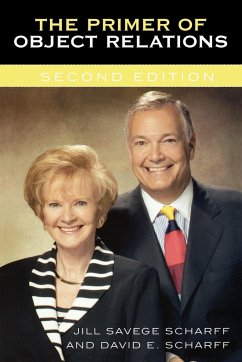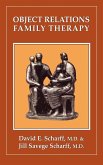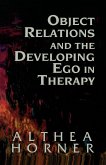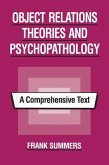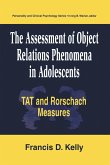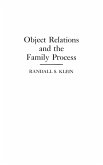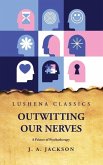- Broschiertes Buch
- Merkliste
- Auf die Merkliste
- Bewerten Bewerten
- Teilen
- Produkt teilen
- Produkterinnerung
- Produkterinnerung
This is the second edition of a comprehensive manual that has become a classic in the field. In clear, readable prose it describes object relations theory and its use in psychotherapy.
Andere Kunden interessierten sich auch für
![The Social Cognition and Object Relations Scale-Global Rating Method (Scors-G) The Social Cognition and Object Relations Scale-Global Rating Method (Scors-G)]() Michelle SteinThe Social Cognition and Object Relations Scale-Global Rating Method (Scors-G)186,99 €
Michelle SteinThe Social Cognition and Object Relations Scale-Global Rating Method (Scors-G)186,99 €![Object Relations Family Therapy Object Relations Family Therapy]() David E. ScharffObject Relations Family Therapy178,99 €
David E. ScharffObject Relations Family Therapy178,99 €![Object Relations and the Developing Ego in Therapy Object Relations and the Developing Ego in Therapy]() Althea J. HornerObject Relations and the Developing Ego in Therapy117,99 €
Althea J. HornerObject Relations and the Developing Ego in Therapy117,99 €![Object Relations Theories and Psychopathology Object Relations Theories and Psychopathology]() Frank SummersObject Relations Theories and Psychopathology73,99 €
Frank SummersObject Relations Theories and Psychopathology73,99 €![The Assessment of Object Relations Phenomena in Adolescents The Assessment of Object Relations Phenomena in Adolescents]() Francis D. KellyThe Assessment of Object Relations Phenomena in Adolescents72,99 €
Francis D. KellyThe Assessment of Object Relations Phenomena in Adolescents72,99 €![Object Relations and the Family Process Object Relations and the Family Process]() Randall KleinObject Relations and the Family Process101,99 €
Randall KleinObject Relations and the Family Process101,99 €![Outwitting Our Nerves A Primer of Psychotherapy Outwitting Our Nerves A Primer of Psychotherapy]() Josephine Agnes JacksonOutwitting Our Nerves A Primer of Psychotherapy49,99 €
Josephine Agnes JacksonOutwitting Our Nerves A Primer of Psychotherapy49,99 €-
-
-
This is the second edition of a comprehensive manual that has become a classic in the field. In clear, readable prose it describes object relations theory and its use in psychotherapy.
Hinweis: Dieser Artikel kann nur an eine deutsche Lieferadresse ausgeliefert werden.
Hinweis: Dieser Artikel kann nur an eine deutsche Lieferadresse ausgeliefert werden.
Produktdetails
- Produktdetails
- Verlag: Jason Aronson, Inc.
- Second Edition
- Seitenzahl: 274
- Erscheinungstermin: 3. Mai 2005
- Englisch
- Abmessung: 229mm x 152mm x 16mm
- Gewicht: 449g
- ISBN-13: 9780765703477
- ISBN-10: 0765703475
- Artikelnr.: 21328705
- Herstellerkennzeichnung
- Libri GmbH
- Europaallee 1
- 36244 Bad Hersfeld
- gpsr@libri.de
- Verlag: Jason Aronson, Inc.
- Second Edition
- Seitenzahl: 274
- Erscheinungstermin: 3. Mai 2005
- Englisch
- Abmessung: 229mm x 152mm x 16mm
- Gewicht: 449g
- ISBN-13: 9780765703477
- ISBN-10: 0765703475
- Artikelnr.: 21328705
- Herstellerkennzeichnung
- Libri GmbH
- Europaallee 1
- 36244 Bad Hersfeld
- gpsr@libri.de
By Jill Savege Scharff and David E. Scharff
Chapter 1 The Self and Its Objects Chapter 2 Basic Freudian Concepts
Chapter 3 From Freud to Object Relations Theory Chapter 4 Endopsychic
Structure Chapter 5 Projective and Introjective Identification and
Containment Chapter 6 The Holding Environment Chapter 7 The Concept of
Positions Chapter 8 Attachment Theory Chapter 9 Trauma Chapter 10 Chaos
Theory Chapter 11 The Therapeutic Relationship and the Geography of the
Transference Chapter 12 Relation to Other Theoretical Systems and Clinical
Approaches Chapter 13 Principles of Assessment Chapter 14 Technique I:
Setting the Frame, Impartiality, Psychological Space, and the Use of the
Therapist's Self Chapter 15 Technique II: Working with Transference,
Countertransference, and Interpretation Chapter 16 Technique III: The Use
of Dreams, Fantasy, and Play Chapter 17 Brief Therapy Chapter 18 Technique
and Theory Review with Clinical Illustration Chapter 19 Working Through and
Termination Chapter 20 Integration of Individual Therapy with Couple,
Family, Group, and Sex Therapies Chapter 21 The Application of Object
Relations Theory to Various Syndromes and Populations Chapter 22 The Role
and Experience of the Object Relations Therapist Chapter 23 The Development
of Therapeutic Capacity Chapter 24 A Guide to Further Reading Chapter 25
References
Chapter 3 From Freud to Object Relations Theory Chapter 4 Endopsychic
Structure Chapter 5 Projective and Introjective Identification and
Containment Chapter 6 The Holding Environment Chapter 7 The Concept of
Positions Chapter 8 Attachment Theory Chapter 9 Trauma Chapter 10 Chaos
Theory Chapter 11 The Therapeutic Relationship and the Geography of the
Transference Chapter 12 Relation to Other Theoretical Systems and Clinical
Approaches Chapter 13 Principles of Assessment Chapter 14 Technique I:
Setting the Frame, Impartiality, Psychological Space, and the Use of the
Therapist's Self Chapter 15 Technique II: Working with Transference,
Countertransference, and Interpretation Chapter 16 Technique III: The Use
of Dreams, Fantasy, and Play Chapter 17 Brief Therapy Chapter 18 Technique
and Theory Review with Clinical Illustration Chapter 19 Working Through and
Termination Chapter 20 Integration of Individual Therapy with Couple,
Family, Group, and Sex Therapies Chapter 21 The Application of Object
Relations Theory to Various Syndromes and Populations Chapter 22 The Role
and Experience of the Object Relations Therapist Chapter 23 The Development
of Therapeutic Capacity Chapter 24 A Guide to Further Reading Chapter 25
References
Chapter 1 The Self and Its Objects Chapter 2 Basic Freudian Concepts
Chapter 3 From Freud to Object Relations Theory Chapter 4 Endopsychic
Structure Chapter 5 Projective and Introjective Identification and
Containment Chapter 6 The Holding Environment Chapter 7 The Concept of
Positions Chapter 8 Attachment Theory Chapter 9 Trauma Chapter 10 Chaos
Theory Chapter 11 The Therapeutic Relationship and the Geography of the
Transference Chapter 12 Relation to Other Theoretical Systems and Clinical
Approaches Chapter 13 Principles of Assessment Chapter 14 Technique I:
Setting the Frame, Impartiality, Psychological Space, and the Use of the
Therapist's Self Chapter 15 Technique II: Working with Transference,
Countertransference, and Interpretation Chapter 16 Technique III: The Use
of Dreams, Fantasy, and Play Chapter 17 Brief Therapy Chapter 18 Technique
and Theory Review with Clinical Illustration Chapter 19 Working Through and
Termination Chapter 20 Integration of Individual Therapy with Couple,
Family, Group, and Sex Therapies Chapter 21 The Application of Object
Relations Theory to Various Syndromes and Populations Chapter 22 The Role
and Experience of the Object Relations Therapist Chapter 23 The Development
of Therapeutic Capacity Chapter 24 A Guide to Further Reading Chapter 25
References
Chapter 3 From Freud to Object Relations Theory Chapter 4 Endopsychic
Structure Chapter 5 Projective and Introjective Identification and
Containment Chapter 6 The Holding Environment Chapter 7 The Concept of
Positions Chapter 8 Attachment Theory Chapter 9 Trauma Chapter 10 Chaos
Theory Chapter 11 The Therapeutic Relationship and the Geography of the
Transference Chapter 12 Relation to Other Theoretical Systems and Clinical
Approaches Chapter 13 Principles of Assessment Chapter 14 Technique I:
Setting the Frame, Impartiality, Psychological Space, and the Use of the
Therapist's Self Chapter 15 Technique II: Working with Transference,
Countertransference, and Interpretation Chapter 16 Technique III: The Use
of Dreams, Fantasy, and Play Chapter 17 Brief Therapy Chapter 18 Technique
and Theory Review with Clinical Illustration Chapter 19 Working Through and
Termination Chapter 20 Integration of Individual Therapy with Couple,
Family, Group, and Sex Therapies Chapter 21 The Application of Object
Relations Theory to Various Syndromes and Populations Chapter 22 The Role
and Experience of the Object Relations Therapist Chapter 23 The Development
of Therapeutic Capacity Chapter 24 A Guide to Further Reading Chapter 25
References

